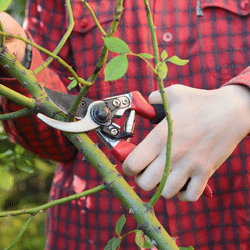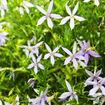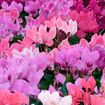

What to Do in the Garden in December: Winter Gardening Jobs
Crisp, frosty mornings and crackling fires. Winter is here! This is undoubtedly a quieter moment in the gardener’s year, though still not a time to hang up the tools completely.
Winter gardening jobs include bare-root planting, woody pruning, and giving plants, soil, and tools a little extra TLC to help make it through these harshest of months. There are even a few bits of propagation! The garden never truly sleeps.
So, throw on those Christmas jumpers and get ready to brave the cold, warm in the knowledge these few jobs will have your garden in fine fettle come spring.
Contents
- Trees, hedges, and shrubs
- Flowers
- Garden maintenance
- Pests and diseases


Trees, hedges and shrubs
Plant bare root hedges – We’re in prime bare root season! Plant bare-root hedging as long as the ground isn’t waterlogged, frozen, or covered in snow. Yew, beech, and hornbeam are some of our most popular options. We recommended planting bare roots as soon as possible to prevent the roots from drying out. Discover our step-by-step guide on How to Plant a Bare-Root Hedge here.
Plant root ball hedging – As well as bare roots, December is an excellent time to plant root ball hedging (this is a cost-effective way of buying larger, more established hedging plants). Root ball plants should be planted immediately after delivery, but if weather conditions aren’t suitable, store the plants in a sheltered, dry, and cool place while keeping the roots moist. Water well once planted.
Transplant established deciduous plants – Whether you’re regretting your choice of planting position or making changes to the layout of your garden, December is a good time to move deciduous trees or shrubs. Success is most likely to be had during the first five years in the ground – after this it is more of a gamble. The priority is to minimise water loss, so choose an overcast, calm day, wrap the rootball in damp hessian while it's out of the ground, and have the new planting hole already prepared. Water and mulch generously, then feed in spring and keep well-watered throughout the first growing season.
Prune trees, shrubs, and hedges – While routine hedge trimming should be done by late summer/ early autumn, (see our How to Trim a Hedge blog), what you can be doing now is more drastic, hard pruning to reduce the overall size of a hedge. This is best done during dormancy (November to March), so that the plants don’t lose too much sap from the pruning cuts. Do a little research beforehand to check your hedge can tolerate this treatment. Beech, hawthorn, hornbeam, yew, holly, and shrubby honeysuckle all respond well.
Many deciduous shrubs, such as cotinus, forsythia, and lilac can also be given a hard prune between November and March. Simply take out any older, less productive stems to just above ground level.
Protect trees and shrubs from frost – Even hardy trees, shrubs, and hedges can be vulnerable to frost when newly planted. If you’re expecting a cold snap, a protective covering of fleece is ideal. In the event of a heavy snowfall, try to get out and brush snow from your evergreens so they don’t splay or break under the weight. Check out our Winter Hedge Care blog for more tips.
Apply a thick layer of mulch to newly planted or vulnerable roots – It’s not just top growth that needs wrapping up against the cold, roots need protecting too. A generous mulch provides insulation, and has the added benefit of gradually breaking down to improve the soil. This is essential for newly planted trees, shrubs, and hedges, and strongly advised for established planting too.
Secure and add protection to young plants - There are few things more frustrating than finding your newly planted shrubs and trees blown over by wind or shredded by sharp teeth. If either of these issues are a likely concern, we strongly recommend using garden canes and/ or rabbit guards when planting.
Prune apple and pear trees – December is a good time to prune freestanding apple and pear trees (though not wall-trained specimens which should be pruned in summer). The purpose is to keep them to a manageable size and as productive as possible. Aim for an open centre (think cocktail glass), to allow light and air in. Follow these simple rules and you won’t go far wrong:
- Remove no more than 20% of the canopy.
- Start by taking off dead, diseased, damaged, and crossing branches, as well as any growing downwards or into the centre.
- Shorten last year’s growth by a third.
- Leave young side shoots unpruned.
Browse our extensive range of fruit trees here, or for more cultivation advice, check out our How to Grow Apple Trees guide.
Plant roses but be wary of replant disease – Roses are commonly available as bare root, meaning many of us will be planting them now. Before you do, it is worth knowing that they can struggle in a spot where there has been a rose before (thought to be due to a build-up of soil-based pathogens). Avoid reusing a former rose spot if you can. Where this isn’t possible, try lining the planting hole with a cardboard box and backfilling with soil from elsewhere in the garden. The idea is that by the time the cardboard rots away, the plant will be established enough to cope with whatever awaits it in the surrounding soil.
Prune climbing roses – Whilst the time for pruning most roses is February to March, climbing species can be tackled now. Read our How to Prune Roses blog for detailed instructions.
Secure wall and climbing shrubs - Now is the time to tie any wall or climbing shrubs to their supports, to help avoid wind damage during the months ahead.
Continue to take hardwood cuttings - This easy and reliable propagation method is suitable for many deciduous shrubs, trees, and climbers. Roses, dogwood, willow, jasmine, and figs are just a few examples of plants suitable for this method.
- Choose branches that are pencil-thick, free from disease, and have no flower buds. Cut into 15-30 cm lengths, with a diagonal cut just below a bud.
- Remove leaves and side shoots.
- Insert into containers filled with a gritty compost mix, with two-thirds buried and one-third showing.
- Space cuttings 10-15cm apart.
- Water thoroughly and remember to label!
- Place in a sheltered area, greenhouse, or cold frame for the winter. Keep the compost just moist.
- Check periodically for signs of roots (this can take several months to a year). Gently tug on the cuttings to feel if they've anchored themselves.
- Once the cuttings have developed a good root system, transplant them into their permanent location.
Care for your Christmas tree – The main arboreal interest for many of us at this time of year! To get the most out of yours (and avoid the creeping carpet of sharp needles) follow our handy hints:
- Choose an Abies (fir) or Pinus (pine) rather than the common Picea abies (Norway spruce). These hold onto their needles for much longer.
- Saw off the bottom few centimetres when you get your tree home and use a stand which can hold water.
- Try not to put it next to a fire or radiator.
- Keep the water regularly topped up.
- Potted (i.e., ‘living’) Christmas trees can be kept indoors for a maximum of two weeks before they start to hanker after fresh air.
As well as taking a green-fingered approach to your Christmas tree, why not apply it to your gifts? We may be biassed, but we think plants make far better presents than socks or chocolates! Check out our Garden Plant Gift Ideas for Christmas for inspiration.
Collect evergreen foliage to make a Christmas wreath – This is when those evergreen hedges come in extra handy! Follow the step-by-step guide in our How to Make a Christmas Wreath post to give your front door a festive makeover.
Flowers
Sow flower seeds – While the depths of winter may not feel like a natural time to be sowing seeds, believe it or not there are some plants which respond well to being started off at this time of year. This might be in a protected or heated environment to get a head start on the growing year ahead, or outdoors to give seeds the cold treatment some require to trigger them into growth.
| Sweet peas | Get these hardy annuals started undercover now, and by spring they will be raring to go. |  |
| Aquilegia | Sow this cottage garden favourite outside now for flowers in late spring to early summer. |  |
| Laurentia | Giving this rock garden classic a head start in a heated propagator now will mean sizeable plants by spring. |  |
| Hardy cyclamen | Sow seeds of these outdoors now, scattering around the base of deciduous trees. |  |
Plant flower bulbs - When it comes to bulbs there is one simple rule, to plant during dormancy. This will vary depending on the flowering time:
- Spring-flowering bulbs are dormant in autumn.
- Summer-flowering bulbs are dormant in spring.
- Autumn-flowering bulbs are dormant in summer.
While this tells us winter is not classic bulb-planting season, there is one spring-flowering bulb that will cope with being planted now – the tulip. Simply avoid very wet or frozen days, and plant as you would in autumn.
Garden maintenance
Melt frozen pond water – An iced-over pond means those creatures living beneath can be starved of oxygen, and those which depend on it for drinking water can go thirsty. During a prolonged freeze, you can help by using a pan of hot water sitting on the ice to gently melt a hole. An alternative approach is to float a few tennis balls in the water whenever a cold snap is expected. In the morning, these can be popped out leaving handy holes. Whatever you do, resist the temptation to smash ice, as this can harm pondlife.
Fix any bare patches of lawn – Where perennials have starved lawn edges of light all summer, a neat fix is to cut out the affected piece with a section of healthy, green lawn included, and rotate it so this is along the lawn edge. The bare patch will soon disappear as it knits with its lush surroundings. For problems on a larger scale, it may be worth replacing with new turf. Check out our Winter Lawn Care guide for more tips and ideas.
Keep off the lawn in frosty weather – Grass is surprisingly vulnerable to damage when frozen. One thoughtless shortcut across a frosty lawn can result in unsightly brown footprints which take weeks to disappear.
Clean and dry garden tools before storing – The relative quiet of December allows focus to be turned to tool maintenance. Clean everything thoroughly with warm soapy water and, if necessary, a steel wool or a wire brush. Dry with clean rags, and if wooden handles are starting to weather, rub them with linseed or Danish oil. Blades (such as on spades, secateurs, loppers, etc.) benefit from an annual sharpening. You can either do this yourself with a sharpening stone or use a professional service.
Store hoses and sprinklers to stop them freezing – Frozen water in irrigation equipment is likely to cause damage, which can be a real headache when you come to use it again in the warmer months. If you can, move equipment into a shed or greenhouse. If not, make sure as much water is drained out as possible, and, where practical, insulate with fleece, hessian, or similar.
General garden hygiene – While it’s good to have ‘rough’ areas where leaves and prunings are left to provide winter habitats for wildlife, it pays to be selective about where you do this. Some plants, such as roses, fruit trees, and anything which has suffered from rust or powdery mildew, should have fallen leaves and waste material removed and disposed of to avoid perpetuating pests and diseases the following year. Whilst we’re on the subject, don’t forget to keep your pruning tools clean and disinfected between plants.
Prepare soil for next year – December is a brilliant time for a spot of soil improvement. The ground is at its barest, and a bit of muck wheelbarrowing can be just the ticket for warming up chilly bodies. The easiest, most effective method is to spread a generous layer (2-3cm) of mulch such as manure, mushroom compost, fine bark, garden compost, or a commercial mix, over the surface and leave nature to incorporate it into the soil. If you have a very compacted area, or are feeling particularly energetic, you may wish to dig it in. Check out our How to Improve Your Soil guide for more info.
Leave food and water out for birds and wildlife - We can make a significant difference to local wildlife populations by providing food and water in our gardens, and this is best done all year-round. Try not to let feeders run out (particularly during the colder months), as birds will use vital energy on a wasted trip. Defrost the water in bird baths and ponds when needed (see ‘Melt frozen pond water’ section above).
If you’re keen on learning more about the wildlife in your garden, visit our How to Make a Wildlife-Friendly Garden and Birds to Spot in Winter blogs.

Pests and diseases
Phytophthora root rot – This fungal disease affects a range of trees, shrubs, and sometimes herbaceous plants. It is particularly prevalent in wet conditions, meaning winter can be a prime time for symptoms to appear. Look out for wilting or yellowing leaves, or branch dieback. Remove and dispose of any plants you suspect to be suffering, improve the drainage of the soil, and replace with a less susceptible alternative. In hedging terms, this includes hornbeam, hazel, honeysuckle, and eleagnus.
Coral spot – This fungal disease can be present at any time of year, though it is winter when branches are bare that we are most likely to spot it. Small orange-pink raised spots form on branches after they have died back. Remove and dispose of swiftly to contain spread.
Holly leaf blight – Another disease that thrives in wet winter weather, this increasingly common problem can be identified by dark leaf blotches, leaf drop and twig dieback. Again, prune out and dispose of infected material as soon as you can.
Watch out for crown or brown rots - Look out for these on dormant perennials, particularly if you garden on clay or poorly drained soil. Unfortunately, the prognosis is usually terminal, and the best action is to dig up and dispose of the plant. Ensuring good drainage and avoiding excessive watering can help prevent the problem in the future.
If you’ve spotted a problem on your hedge which doesn’t seem to match any of these, have a look at our ?11 Popular Garden Pests and Diseases Found in Hedging Plants to see if it’s on there. Don’t say we don’t know how to treat you at Christmas!
We hope you enjoy staying connected to your garden during this festive period. Why not get ahead of the curve by reading our January Monthly Advice Guide to see what’s next in store. Oh, and just one more thing… and have a very merry Christmas from all of us at Hedges Direct!
 Hedges Direct
Hedges Direct 



